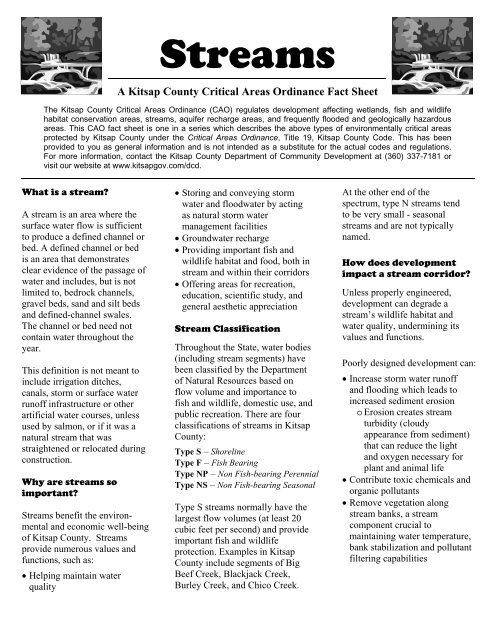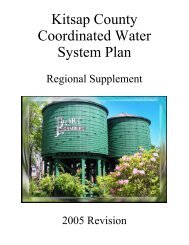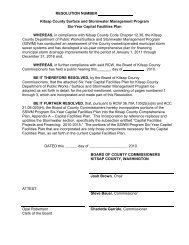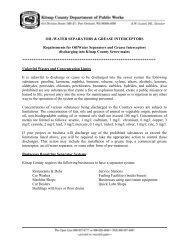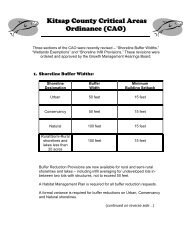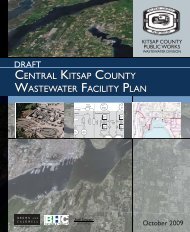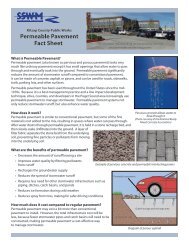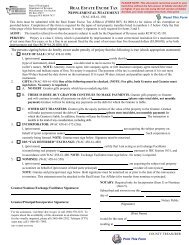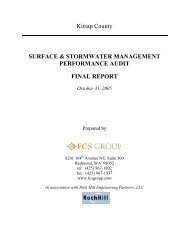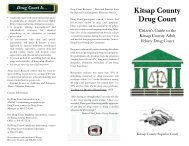Streams - Kitsap County Government
Streams - Kitsap County Government
Streams - Kitsap County Government
Create successful ePaper yourself
Turn your PDF publications into a flip-book with our unique Google optimized e-Paper software.
<strong>Streams</strong><br />
A <strong>Kitsap</strong> <strong>County</strong> Critical Areas Ordinance Fact Sheet<br />
The <strong>Kitsap</strong> <strong>County</strong> Critical Areas Ordinance (CAO) regulates development affecting wetlands, fish and wildlife<br />
habitat conservation areas, streams, aquifer recharge areas, and frequently flooded and geologically hazardous<br />
areas. This CAO fact sheet is one in a series which describes the above types of environmentally critical areas<br />
protected by <strong>Kitsap</strong> <strong>County</strong> under the Critical Areas Ordinance, Title 19, <strong>Kitsap</strong> <strong>County</strong> Code. This has been<br />
provided to you as general information and is not intended as a substitute for the actual codes and regulations.<br />
For more information, contact the <strong>Kitsap</strong> <strong>County</strong> Department of Community Development at (360) 337-7181 or<br />
visit our website at www.kitsapgov.com/dcd.<br />
What is a stream?<br />
A stream is an area where the<br />
surface water flow is sufficient<br />
to produce a defined channel or<br />
bed. A defined channel or bed<br />
is an area that demonstrates<br />
clear evidence of the passage of<br />
water and includes, but is not<br />
limited to, bedrock channels,<br />
gravel beds, sand and silt beds<br />
and defined-channel swales.<br />
The channel or bed need not<br />
contain water throughout the<br />
year.<br />
This definition is not meant to<br />
include irrigation ditches,<br />
canals, storm or surface water<br />
runoff infrastructure or other<br />
artificial water courses, unless<br />
used by salmon, or if it was a<br />
natural stream that was<br />
straightened or relocated during<br />
construction.<br />
Why are streams so<br />
important?<br />
<strong>Streams</strong> benefit the environmental<br />
and economic well-being<br />
of <strong>Kitsap</strong> <strong>County</strong>. <strong>Streams</strong><br />
provide numerous values and<br />
functions, such as:<br />
• Helping maintain water<br />
quality<br />
• Storing and conveying storm<br />
water and floodwater by acting<br />
as natural storm water<br />
management facilities<br />
• Groundwater recharge<br />
• Providing important fish and<br />
wildlife habitat and food, both in<br />
stream and within their corridors<br />
• Offering areas for recreation,<br />
education, scientific study, and<br />
general aesthetic appreciation<br />
Stream Classification<br />
Throughout the State, water bodies<br />
(including stream segments) have<br />
been classified by the Department<br />
of Natural Resources based on<br />
flow volume and importance to<br />
fish and wildlife, domestic use, and<br />
public recreation. There are four<br />
classifications of streams in <strong>Kitsap</strong><br />
<strong>County</strong>:<br />
Type S – Shoreline<br />
Type F – Fish Bearing<br />
Type NP – Non Fish-bearing Perennial<br />
Type NS – Non Fish-bearing Seasonal<br />
Type S streams normally have the<br />
largest flow volumes (at least 20<br />
cubic feet per second) and provide<br />
important fish and wildlife<br />
protection. Examples in <strong>Kitsap</strong><br />
<strong>County</strong> include segments of Big<br />
Beef Creek, Blackjack Creek,<br />
Burley Creek, and Chico Creek.<br />
At the other end of the<br />
spectrum, type N streams tend<br />
to be very small - seasonal<br />
streams and are not typically<br />
named.<br />
How does development<br />
impact a stream corridor?<br />
Unless properly engineered,<br />
development can degrade a<br />
stream’s wildlife habitat and<br />
water quality, undermining its<br />
values and functions.<br />
Poorly designed development can:<br />
• Increase storm water runoff<br />
and flooding which leads to<br />
increased sediment erosion<br />
o Erosion creates stream<br />
turbidity (cloudy<br />
appearance from sediment)<br />
that can reduce the light<br />
and oxygen necessary for<br />
plant and animal life<br />
• Contribute toxic chemicals and<br />
organic pollutants<br />
• Remove vegetation along<br />
stream banks, a stream<br />
component crucial to<br />
maintaining water temperature,<br />
bank stabilization and pollutant<br />
filtering capabilities
Buffers and Building<br />
Setbacks<br />
As with streams, most critical areas<br />
are provided a buffer of native<br />
vegetation to protect them from<br />
human activities. No clearing or<br />
grading is allowed within this buffer<br />
or within the critical area itself. In<br />
addition, structures and impervious<br />
surfaces must be kept outside a 15<br />
foot building setback that extends<br />
beyond the buffer. In most cases,<br />
existing structures within a stream<br />
buffer may be remodeled,<br />
reconstructed or replaced.<br />
Standard buffer width requirements<br />
depend on the stream type. These<br />
are minimum requirements and may<br />
be increased to protect a stream. The<br />
buffer requirements are as follows:<br />
• Type S – 200 feet<br />
• Type F – 150 feet<br />
• Type NP – 50 feet<br />
• Type NS – 50 feet<br />
Buffers begin at the “ordinary high<br />
water mark” (OHWM) of the stream<br />
channel and extend in either<br />
direction.<br />
The OHWM is typically placed at<br />
the line often found on the stream<br />
bank which is the average extent of<br />
high water.<br />
Alternatively, the OHWM may be<br />
placed at the top of the bank when the<br />
line is not visible, or where the vegetation<br />
changes to an upland type.<br />
Buffer widths are increased if there are<br />
streamside wetlands that provide<br />
overflow storage for stormwater.<br />
Wetlands feed water back to the stream<br />
during low flows and provide shelter<br />
and food for fish.<br />
In consultation with the Washington<br />
Dept. of Fish and Wildlife, <strong>Kitsap</strong><br />
<strong>County</strong> has the administrative flexibility<br />
to reduce buffers on existing platted lots.<br />
Alteration of a stream or its buffer may<br />
require a mitigation plan with the<br />
<strong>County</strong>. The applicant must also meet<br />
the requirements of other jurisdictions,<br />
such as the Department of Fish and<br />
Wildlife’s Hydraulic Project Approval<br />
(HPA).<br />
<strong>Streams</strong> in Ravines<br />
For streams in ravines with ravine sides<br />
10 feet or greater in height, the<br />
minimum buffer width must be the<br />
minimum buffer required for the stream<br />
type, or a buffer width which extends 25<br />
feet beyond the top of the slope,<br />
whichever is greater.<br />
Stream Crossings<br />
Bridges or bottomless culverts are<br />
required for all Type S and F streams,<br />
which support salmonids, unless it can<br />
be demonstrated to the <strong>County</strong> that<br />
impacts to salmon habitat can be<br />
mitigated.<br />
To obtain a stream crossing permit<br />
(HPA) contact the Department of<br />
Fish and Wildlife at 360-249-6522.<br />
Livestock Restrictions<br />
In areas that would allow livestock<br />
to access streams, damage should be<br />
avoided by:<br />
• Fencing along a stream’s outer<br />
buffer edge<br />
• Implementing to the satisfaction of<br />
the <strong>Kitsap</strong> Conservation District a<br />
farm conservation plan that would<br />
protect and enhance stream quality<br />
Other Restrictions and<br />
Provisions<br />
Examples of activities that are<br />
subject to the standards contained in<br />
the CAO and other applicable<br />
federal, state and local ordinances<br />
include:<br />
• Forest practices, Class IV General<br />
and Conversion Option Harvest<br />
Plans (COHPs).<br />
• Land division and land use<br />
permits<br />
• Road construction<br />
Prepared by the <strong>Kitsap</strong> <strong>County</strong><br />
Department of Community Development


